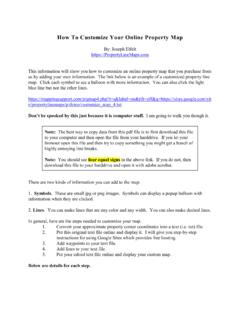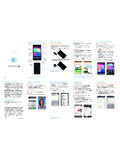Transcription of 246-29: Using Styles and Templates to Customize …
1 1 Paper 246-29 Using Styles and Templates to Customize SAS ODS Output Sunil K. Gupta, Gupta Programming, Simi Valley, CA ABSTRACT SAS s new Output Delivery System (ODS) feature enables the creation of various new file types including Rich Text Format (RTF), PostScript and HTML. The standard default style used to control the output is generally well organized and sufficient for most purposes. When the default SAS ODS output report will no longer suffice, SAS users can take advantage of ODS advanced features to Customize the output report with Styles and Templates . By having greater control over the report details such as color, font, size, justification, order and labels, the format and quality of the report will be enhanced.
2 This paper introduces the concepts necessary to understand and apply the advanced features of SAS s ODS. Issues in defining and selecting output destinations, selecting output objects and creating customized output files will be discussed. The focus is on the creation of custom Styles and Templates with PROC template for visually appealing output. INTRODUCTION SAS s new ODS features offer significant improvements in the presentation of reports and files. Some of ODS s advantages include the following: Creation of output objects from most all procedures Creation of RTF, HTML and PostScript files Creation of data sets from output objects The advanced features of ODS enable greater control and flexibility for the presentation of the data.
3 Some of ODS s advanced features include the following: Control of format and style of report font, color, etc. Support for web site development and management Creation of a navigational system This paper will show how to apply the advanced features of ODS to create customized HTML files for Proc FREQ results. By Using style and table Templates , programmers have greater control on report details such as colors, fonts, size, data justification, order and label to meet the company s standards. This paper will show the steps involved in converting the default style and table template to a customized style and table template .
4 The custom style and table template will be saved to a permanent template store location for multi-use access and repeated utilization. This paper will not review the alternatives to Using style definitions and table template such as customizing labels with PROC LABEL, RTF in-line formatting (Font, Bold, Italic, Size, Superscript, Subscript, RTF Control Words), the style option in PROC TABULATE, REPORT, or PRINT, or the Style Editor in Enterprise Guide. The Style Editor in Enterprise Guide makes the process of creating style definitions easy through a graphic menu interface. Before constructing a new style template , all available Styles included in the installation should be considered.
5 The closest existing standard style to the company s standard should be used as the model for the customized style. This paper will demonstrate how to Customize the following items Using style & table Templates : STYLE CONTROLS Change fonts Change background image and margin Change table header Change titles Change footer Change table Create row header Change HTML content and page file title SUGI 29 Tutorials 2 TABLE CONTROLS Select columns Change header text and span columns Change row header attributes Change frequency column attributes Change percent column attributes with traffic lighting condition Change footer text FROM.
6 DEFAULT STYLE & template TO: CUSTOM Styles TO: CUSTOM TABLE template TO: CUSTOM Styles AND TABLE Templates SUGI 29 Tutorials 3 ODS BASICS AND PROCESSES The sequence of steps to follow in Using ODS for report generation include the following: 1. Defining Output Destinations 2. Creating Output Files with Style 3. Selecting Output Objects (Optional) 4. Using Styles and Templates to Customize Output (Optional) When working in the ODS environment, it is helpful to consider the following definitions: (Note these are not SAS Institute s official definitions.)
7 1. DESTINATION Final File Type Where you want to be? (List, HTML, RTF, Printer, PDF, Data set) 2. OBJECT A Non-Physical Item What you have to work with? (Select or Exclude Output Objects) 3. STANDARD REPORT As-Is Final End Product How you will reach your destination? (Default Attributes defined in Default Style & template ) 4. CUSTOM REPORT Focused Final End Product How you can control your destination? (Custom Style & template ) 1. DEFINING OUTPUT DESTINATIONS In defining the destinations to use, ODS needs to open and then close the output destination. More than one destination may be defined.
8 Currently, the available output destinations include: Standard SAS List HTML RTF Output - SAS Data Set, XML Printer PostScript, PDF, PCL Styles set at the ODS statement will remain in effect until changed to another style or until the destination is closed. OUTPUT DESTINATIONS Standard: SAS List HTML ODS RTF Output: SAS Data set Printer: PS, PDF, XML PCL 2. CREATING OUTPUT FILES WITH STYLE Not all destinations support all Templates available.
9 The table and column Templates are supported by all destinations because the Templates are internal to the output object. The style Templates , however, are supported by destinations that support report details such as color, font and size. The RTF and HTML destinations will be reviewed as examples. SUGI 29 Tutorials 4 template SUPPORT BY DESTINATION DESTINATION SUPPORT TABLE/COLUMN SUPPORT STYLE Listing Yes No Printer Yes Yes RTF Yes Yes Data Set Yes No HTML Yes Yes The two options for creating reports are to use the default style or to specify a different style.
10 The style specified must first be defined and accessible. To send output to a destination file, use the file = option with the appropriate file type. ODS DESTINATION FILE= STYLE = style-spec; Where DESTINATION is one of the following: RTF, Printer or HTML. * Example: Create RTF file with SAS supplied style; ODS RTF FILE='c:\sasgroup\SUGI29\ ' STYLE=barrettsblue; PROC FREQ DATA=DEMOG; TABLES DRUG; RUN; ODS RTF CLOSE; Creating HTML Files FRAME The HTML file destination saves the content into logical files.















